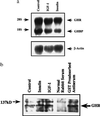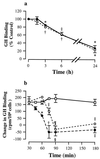Insulin and insulin-like growth factor-I acutely inhibit surface translocation of growth hormone receptors in osteoblasts: a novel mechanism of growth hormone receptor regulation
- PMID: 9326618
- PMCID: PMC23473
- DOI: 10.1073/pnas.94.21.11381
Insulin and insulin-like growth factor-I acutely inhibit surface translocation of growth hormone receptors in osteoblasts: a novel mechanism of growth hormone receptor regulation
Abstract
We previously have demonstrated that insulin and insulin-like growth factor-I (IGF-I) down-regulate growth hormone (GH) binding in osteoblasts by reducing the number of surface GH receptors (GHRs). The present study was undertaken to investigate the mechanism of GHR down-regulation. Treatment with 5 nM insulin or IGF-I for 18 hr significantly decreased surface GH binding to 26.4 +/- 2.9% and 23.0 +/- 2.7% of control (mean +/- SE; P < 0.05), respectively. No corresponding reductions in the mRNA level and total cellular content of GHR were found, nor was the rate of receptor internalization affected. The effects on GHR translocation were assessed by measuring the reappearance of GH binding of whole cells after trypsinization to remove the surface receptors. GH binding of control cultures significantly increased (P < 0.05) over 2 hr after trypsinization, whereas no recovery of binding activity was detected in insulin and IGF-I-treated cultures, indicating that GHR translocation was impaired. Studies on the time course of GHR down-regulation revealed that surface GH binding was reduced significantly by 3-hr treatment (P </= 0.0005), whereas GHR translocation was completely abolished by 75-90 min with insulin and IGF-I. The inhibition of receptor translocation by insulin, but not IGF-I, was attenuated by wortmannin. In conclusion, insulin and IGF-I down-regulated GH binding in osteoblasts by acutely impairing GHR translocation, with their effects exerted through distinct postreceptor signaling pathways.
Figures






Similar articles
-
Insulin-like growth factor I and insulin down-regulate growth hormone (GH) receptors in rat osteoblasts: evidence for a peripheral feedback loop regulating GH action.Endocrinology. 1996 Jul;137(7):2694-702. doi: 10.1210/endo.137.7.8770888. Endocrinology. 1996. PMID: 8770888
-
Insulin regulation of human hepatic growth hormone receptors: divergent effects on biosynthesis and surface translocation.J Clin Endocrinol Metab. 2000 Dec;85(12):4712-20. doi: 10.1210/jcem.85.12.7017. J Clin Endocrinol Metab. 2000. PMID: 11134133
-
Differential regulation by growth hormone (GH) of insulin-like growth factor I and GH receptor/binding protein gene expression in rat liver.Endocrinology. 1992 Jun;130(6):3257-64. doi: 10.1210/endo.130.6.1375898. Endocrinology. 1992. PMID: 1375898
-
Clinical review 112: Does serum growth hormone (GH) binding protein reflect human GH receptor function?J Clin Endocrinol Metab. 2000 Mar;85(3):927-32. doi: 10.1210/jcem.85.3.6461. J Clin Endocrinol Metab. 2000. PMID: 10720017 Review.
-
Classical and novel GH receptor signaling pathways.Mol Cell Endocrinol. 2020 Dec 1;518:110999. doi: 10.1016/j.mce.2020.110999. Epub 2020 Aug 22. Mol Cell Endocrinol. 2020. PMID: 32835785 Free PMC article. Review.
Cited by
-
Estrogens regulate the hepatic effects of growth hormone, a hormonal interplay with multiple fates.Front Endocrinol (Lausanne). 2013 Jun 3;4:66. doi: 10.3389/fendo.2013.00066. eCollection 2013. Front Endocrinol (Lausanne). 2013. PMID: 23761784 Free PMC article.
-
Acromegaly pathogenesis and treatment.J Clin Invest. 2009 Nov;119(11):3189-202. doi: 10.1172/JCI39375. Epub 2009 Nov 2. J Clin Invest. 2009. PMID: 19884662 Free PMC article. Review.
-
Can Human Growth Hormone Accelerate Tendon and Ligament Injury Recovery?Sports Health. 2024 Apr 15:19417381241245938. doi: 10.1177/19417381241245938. Online ahead of print. Sports Health. 2024. PMID: 38618948 Free PMC article.
-
A botulinum toxin-derived targeted secretion inhibitor downregulates the GH/IGF1 axis.J Clin Invest. 2012 Sep;122(9):3295-306. doi: 10.1172/JCI63232. Epub 2012 Aug 1. J Clin Invest. 2012. PMID: 22850878 Free PMC article.
-
Mechanisms Underlying the Synergistic Action of Insulin and Growth Hormone on IGF-I and -II Expression in Grass Carp Hepatocytes.Front Endocrinol (Lausanne). 2018 Jun 21;9:336. doi: 10.3389/fendo.2018.00336. eCollection 2018. Front Endocrinol (Lausanne). 2018. PMID: 29977227 Free PMC article.
References
-
- Daughaday W H. Perspect Biol Med. 1989;32:194–211. - PubMed
-
- Isaksson O G P, Jansson J-O, Gause I A M. Science. 1982;216:1237–1239. - PubMed
-
- Waters M J. In: Handbook of Physiology. Kostyo J, editor. Vol. 5. London: Oxford Univ. Press; 1997. in press.
-
- Barnard R, Waters M J. J Endocrinol. 1997;153:1–14. - PubMed
-
- Maes M, Maiter D, Thissen J-P, Underwood L E, Ketelslegers J-M. Trends Endocrinol Metab. 1991;2:92–97. - PubMed
Publication types
MeSH terms
Substances
LinkOut - more resources
Full Text Sources
Medical

